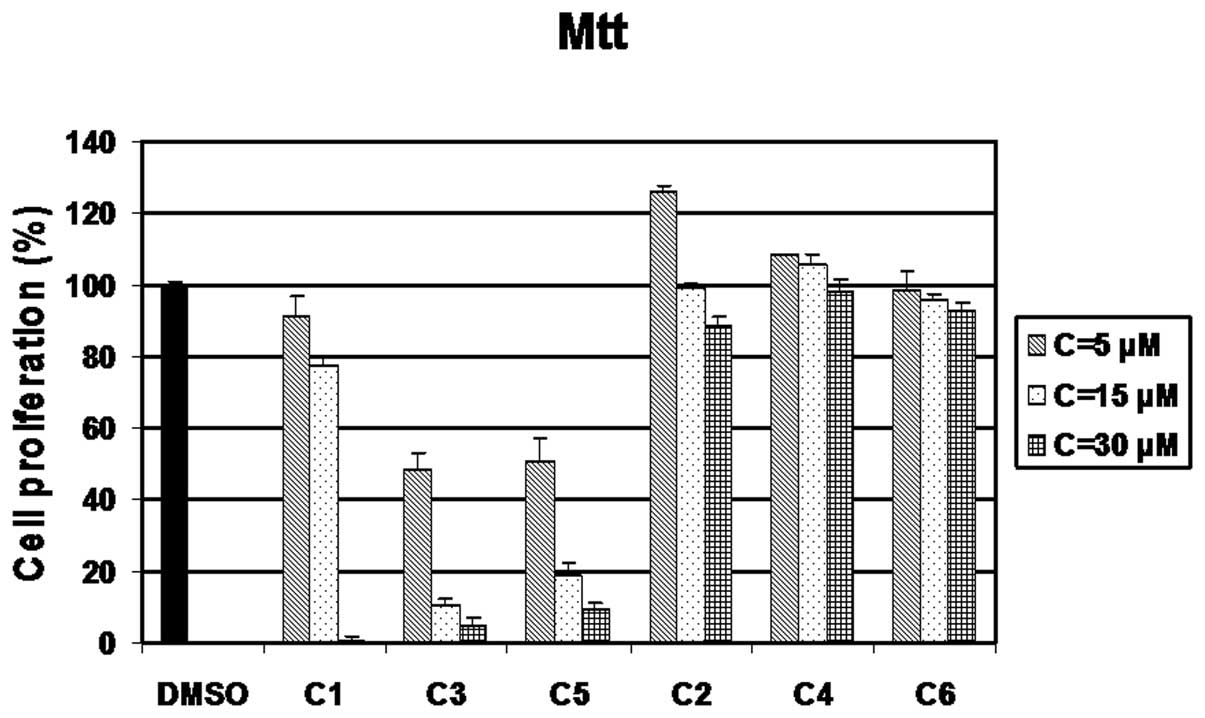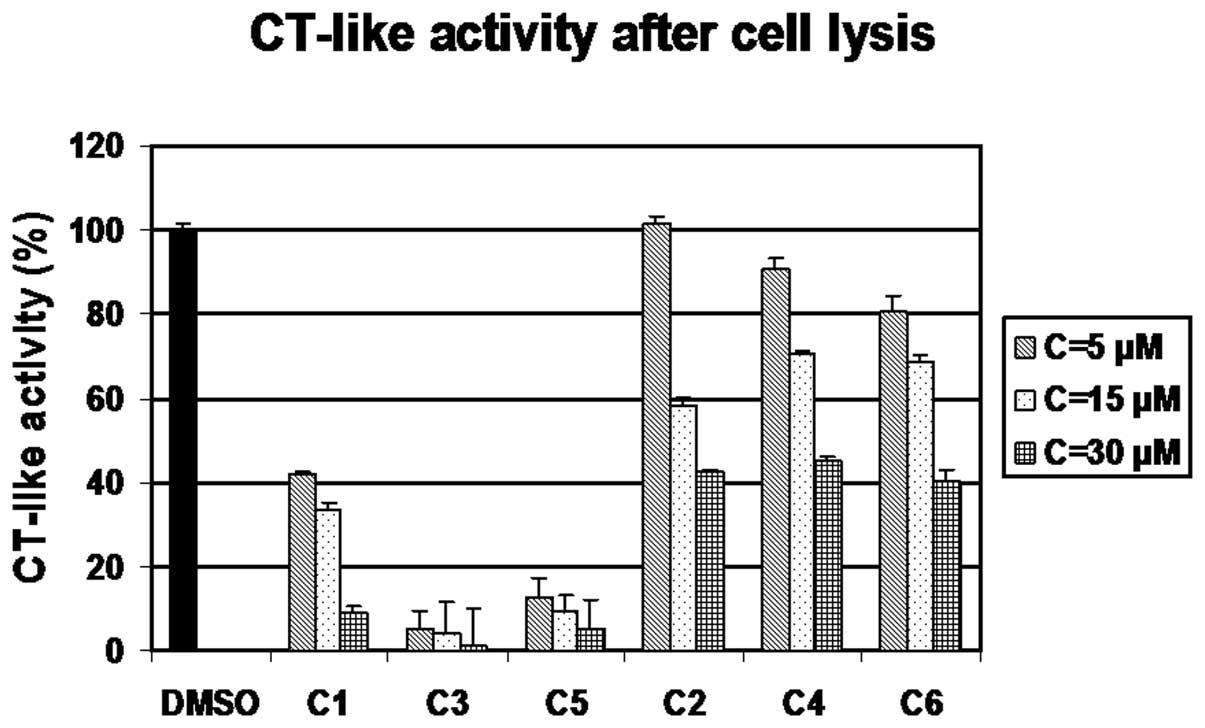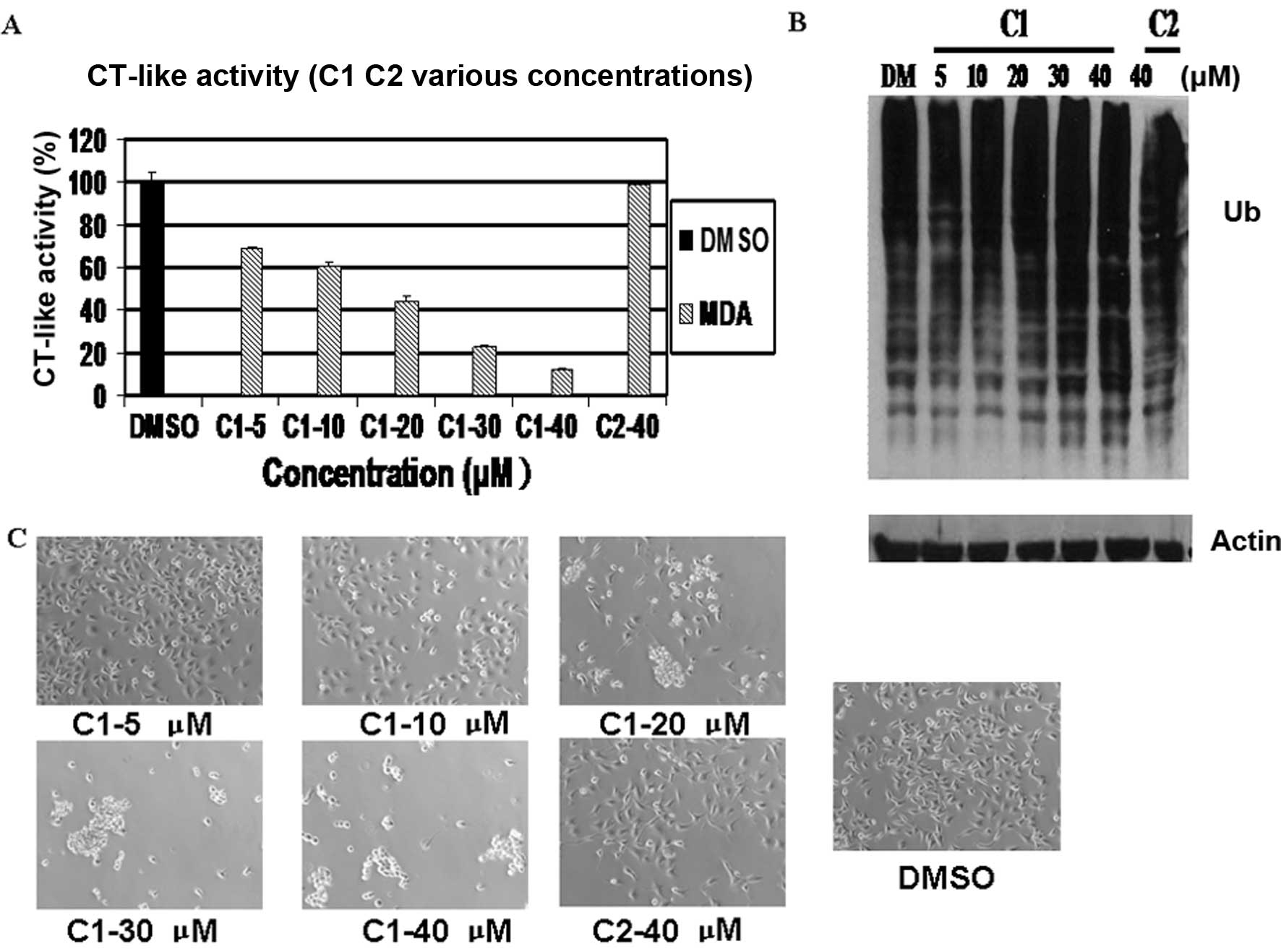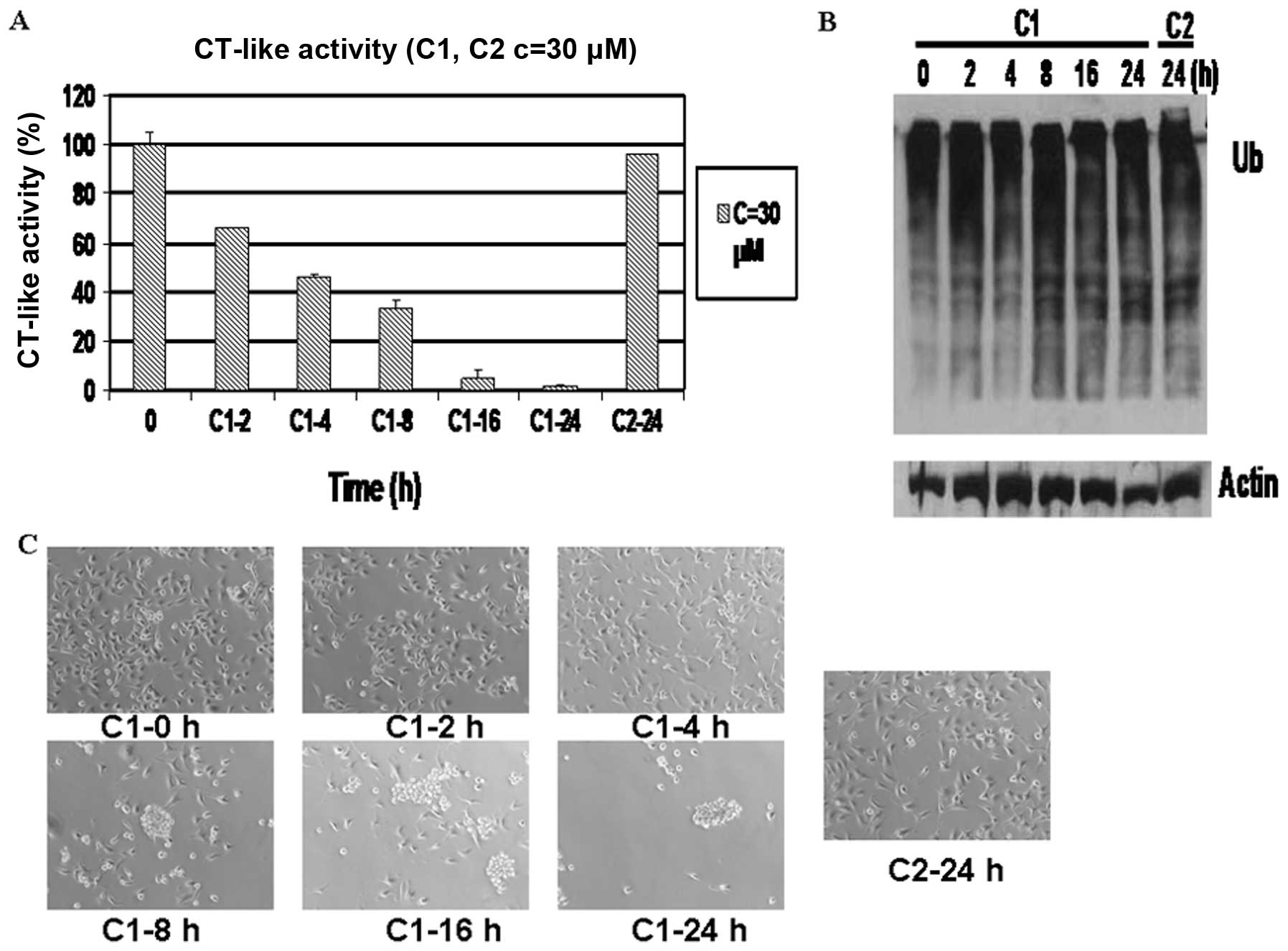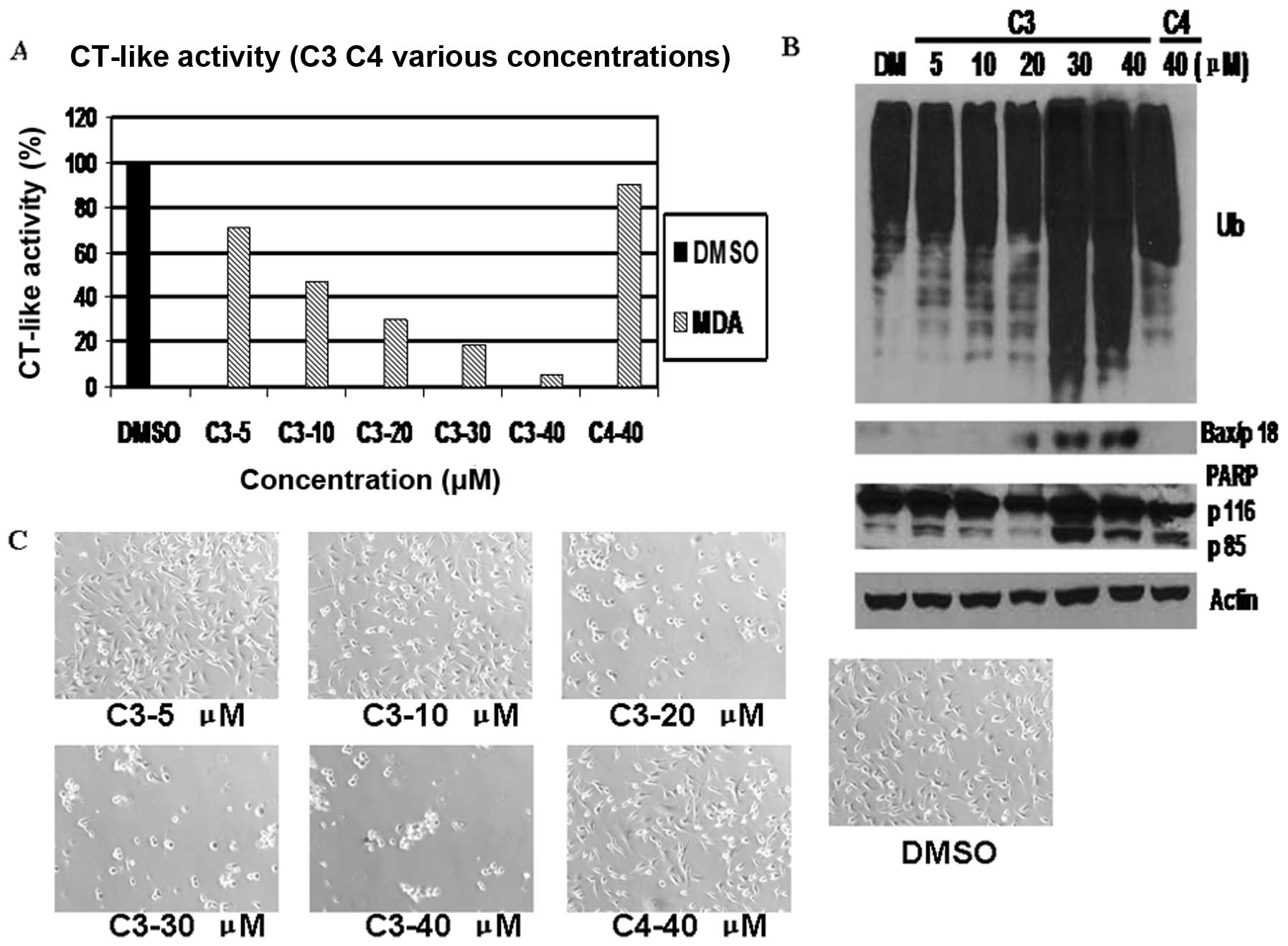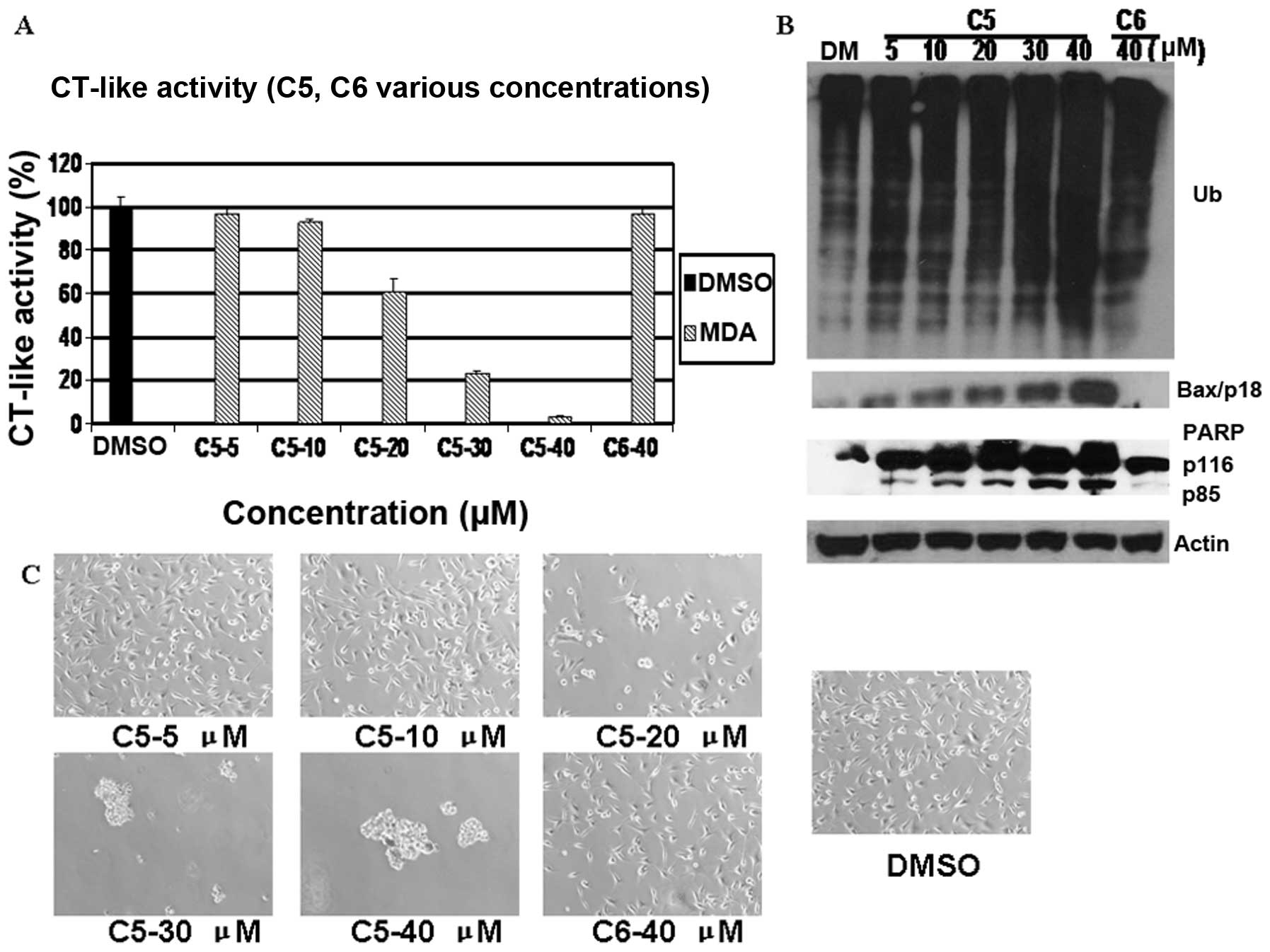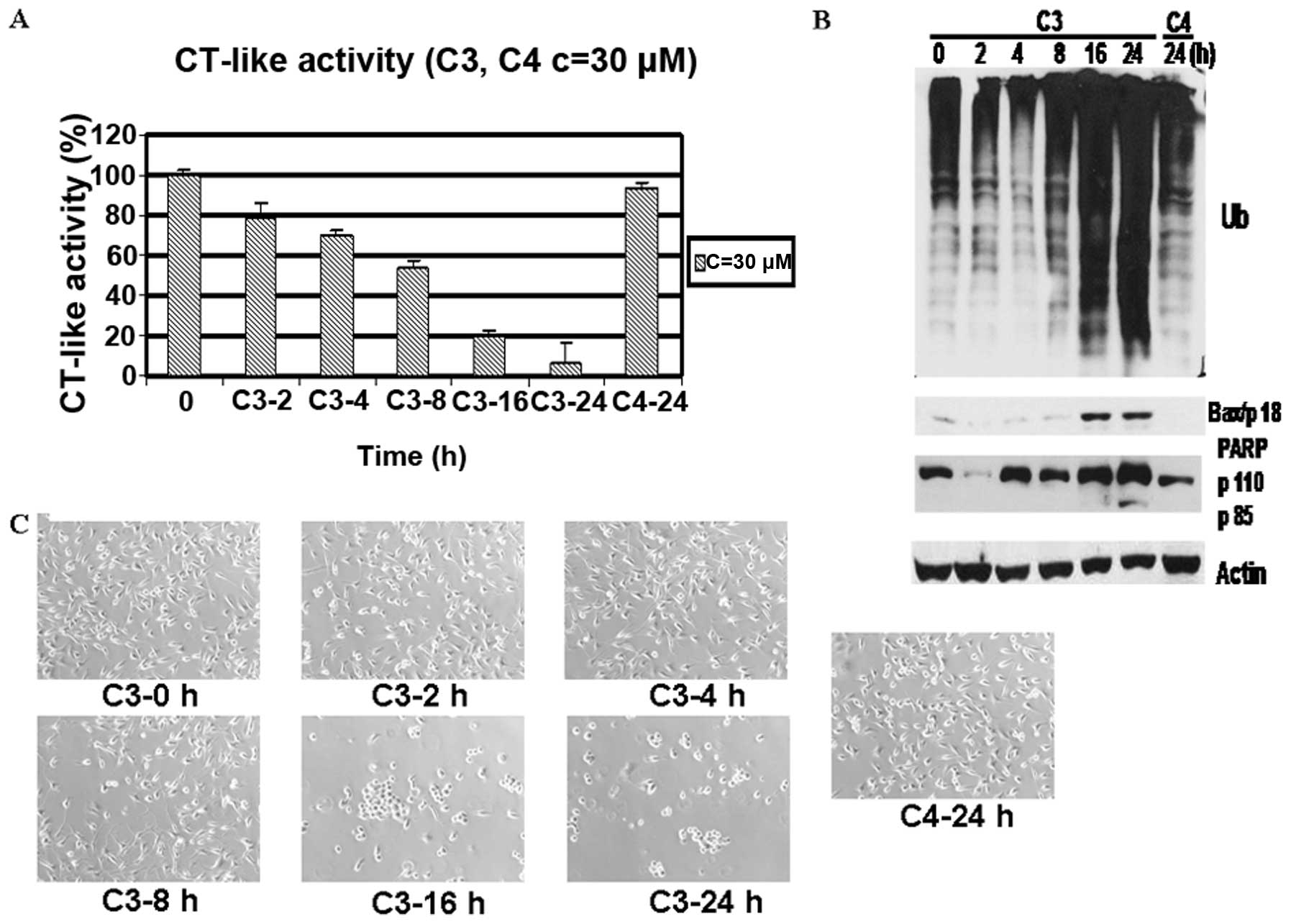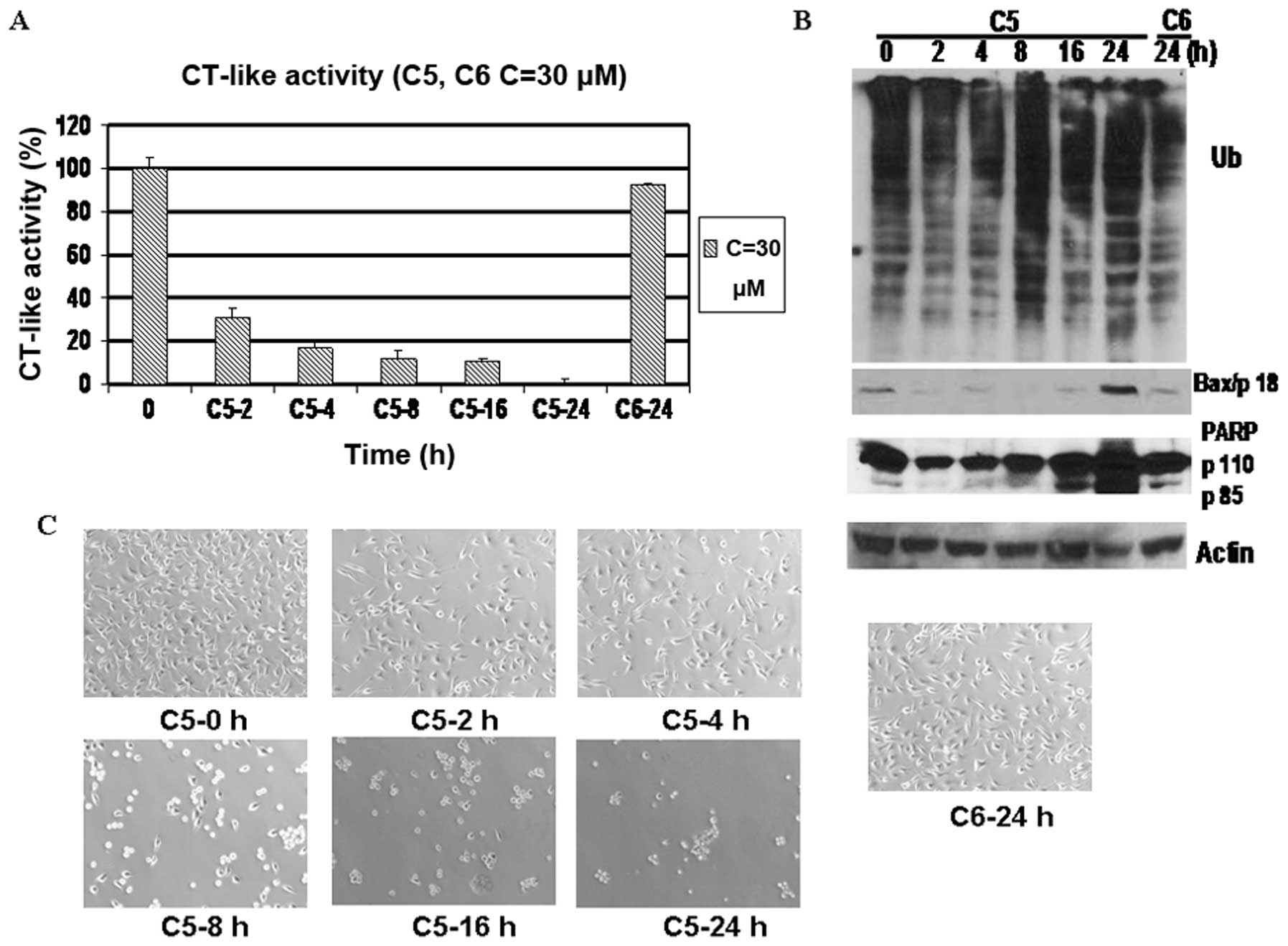Metal-based 2,3-indolinedione derivatives as proteasome inhibitors and inducers of apoptosis in human cancer cells
- Authors:
- Published online on: July 8, 2014 https://doi.org/10.3892/ijmm.2014.1838
- Pages: 870-879
Abstract
Introduction
The ubiquitin-proteasome system (UPS) is a major pathway for intracellular protein degradation and regulates a number of key cellular processes. Its target proteins include a broad array of regulatory proteins that play important roles in cell cycle progression, cell development and differentiation, DNA damage response and tumorgenesis. This system allows the cells to modulate their protein expression patterns in response to changing physiological conditions and plays a critical role in health and disease (1,2). The UPS has therefore been extensively studied as a novel molecular target for the development of novel drugs in an attempt to restore protein homeostasis, as the ultimate therapeutic strategy (3,4). The proteasome is a massive multicatalytic protease responsible for degrading a large number of cellular proteins. In order to be degraded by the proteasome, these target proteins are first tagged with ubiquitin (Ub), which can then target the substrate protein to the 26S proteasome for destruction. The 20S proteasome, the core of the 26S proteasome complex, has at least three distinct catalytic activities, including chymotrypsin-like activity (cleavage after hydrophobic residues by the β5 subunit). Several studies have shown that the inhibition of the proteasomal chymotrypsin-like activity results in the accumulation of several target proteins and the induction of apoptosis in various types of tumor cells (5,6).
Zinc (Zn) was recognized as a trace element with important roles in various metabolic processes in living organisms almost a century ago. Zinc is the second most abundant transition metal ion in the human body and an essential element for the proper function of many different enzymes and the tight control of gene expression (7–9). Cobalt (Co) is also needed in the body and is an essential trace element found in small amounts in different organs and bones. It is an integral part of vitamin B12, which is vital to the formation of red blood cells (10,11). Additionally, cadmium (Cd) has been shown to affect cell proliferation, differentiation and apoptosis (12). The interest in metal-based anticancer drugs has increased since the development of cisplatin (13–16); however, due to the fact that there are many pitfalls in the use of metal-based anticancer drugs, the search for other metals and ligands that may produce more specific antitumor effects is an ongoing process, in an effort to synthesize and characterize novel potential metal-based antitumor drugs that have less toxicity and higher clinical effectiveness (18–20). Our laboratory has studied a number of novel metal-based drugs, including organic copper-, zinc- and cadmium-based complexes, capable of inhibiting the tumor cell proteasome and thus, proliferation, thereby inducing cancer cell death (3,17,21–23). It has also been reported that cobalt-based complexes effectively inhibit chymotrypsin-like activity in the purified proteasome and PC-3 prostate cancer cells (24).
2,3-Indolinedione (isatin; formula, C8H5O2N), an endogenous indole in marine and mammalian organisms, possesses a wide range of biological activities, including anxiogenic, sedative and anticonvulsant activities, and is a potent antagonist of atrial natriuretic peptide receptors. Studies have shown that 2,3-indolinedione and its derivatives have pro-apoptotic functions in human cancer and mouse neuroblastoma cells (25,26).
Considering the importance of the UPS and the properties of 2,3-indolinedione, we aimed to investigate whether 2,3-indolinedione derivatives have the ability to inhibit proteasome activity, and whether structure is an essential factor affecting antitumor activity. To investigate our hypothesis, we synthesized six novel metal compounds (Table I) with 2,3-indolinedione, 2-amino-5-methoxyphenol (N1), 2-amino-5-methylphenol (N2), 3-hydroxy-4-aminobenzoic acid (N3), L-tryptophane (N4) and L-phenylalanine (N5) with Cd (M1), Zn (M2) and Co (M3), respectively (Table I). The compounds were then tested in human breast cancer metal-based complexes in human breast (MDA-MB-231) cells to determine whether compound structure affects proteasome-inhibitory and apoptosis-inducing abilities.
Materials and methods
Materials
Compounds C1-C6 were synthesized by the laboratory at the Ocean University of China, Qingdao, China. 3-(4,5-Dimethylthiazol-2-yl)-2,5-diphenyltetrazolium bromide (MTT), dimethyl sulfoxide (DMSO) and other chemicals were purchased from Sigma-Aldrich (St. Louis, MO, USA). All compounds were dissolved in DMSO at stock concentrations of 80 mM and stored at 4°C. Fetal bovine serum (FBS) was purchased from Aleken Biologicals (Nash, TX, USA). Dulbecco’s modified Eagle’s medium/F12 medium and penicillin/streptomycin were purchased from Invitrogen (Carlsbad, CA, USA). Rabbit polyclonal antibody against human poly(ADP-ribose) polymerase (PARP; H-250), mouse monoclonal antibodies against Ub (P4D1), Bax (B-9), goat polyclonal antibody against β-actin (C-11) and donkey anti-goat secondary antibody were from Santa Cruz Biotechnology, Inc. (Santa Cruz, CA, USA). Goat anti-rabbit and goat anti-mouse secondary antibodies were from Bio-Rad (Hercules, CA, USA).
Metal complex syntheses
C1, C2, C3, C4, C5 and C6: these compounds were synthesized by the laboratory at the Ocean University of China. The ligand (2 mM) was dissolved in 15 ml of ethanol. M (CH3COO)2·2H2O (2 mM) dissolved in 10 ml of anhydrous ethanol was added dropwise to the above solution with stirring and the mixture was reacted for 4 h at 50°C to yield a precipitate, which was filtered off, to produce the final complexes.
C1: yield, 81%; Anal. Calc. for C1 {%, [Cd (C15H11O3N2) (CH3COO)], FW=438.71 g·mol-1}; C, 46.54; H, 3.22; N, 6.39. Found (%): C, 47.02; H, 3.19; N, 6.56. λmax (nm): 232, 285. IR data (KBr, cm-1): 3267.68, υ (-NH-); 1651.35, υ (-C=O); 1618.32, υ (-C=N-); 1590.95, υas (COO-); 1319.99, υs (COO-); 1197.76, υ (-OCH3); 1108.84, υ (-Ph-OH); 478.89, υ (Cd-O). 1H NMR (DMSO, 600 MHz; s, singlet; d, doublet; t, triplet): δ (ppm) 10.498 (s, 1H, -NH-); 7.497 (s, 1H, -Ph-H); 7.340 (d, 1H, -Ph-H); 7.066 (s, 1H, -Ph-H); 6.726 (s, 1H, -Ph-H); 6.462 (s, 1H, -Ph-H); 6.438 (d, 1H, -Ph-H); 6.306 (s, 1H, -Ph-H); 3.323 (d, 3H, -OCH3); 2.614 (t, 3H, -CH3). Thermogravimetric (TG) analysis, residue 30.22% (calculated 29.27%, CdO). Molar conductivity, Λm (S·cm2·mol-1): 19.88.
C2: yield, 85%; Anal. Calc. for C2 {%, [Cd (C15H11O2N2) (CH3COO)], FW=422.72 g·mol-1}; C, 48.30; H, 3.34; N, 6.63. Found (%): C, 48.41; H, 3.31; N, 7.01. λmax (nm): 236, 655. IR data (KBr, cm-1): 3189.68, υ (-NH-); 1648.35, υ (-C=O); 1610.52, υ (-C=N-); 1580.95, υas (COO-); 1327.89, υs (COO-); 1199.56, υ (-Ph-OH); 470.89, υ (Cd-O). 1H NMR (DMSO, 600 MHz; s, singlet; d, doublet; t, triplet): δ (ppm) 10.498 (s, 1H, -NH-); 7.497 (s, 1H, -Ph-H); 7.340 (d, 1H, -Ph-H); 7.066 (s, 1H, -Ph-H); 6.726 (s, 1H, -Ph-H); 6.462 (s, 1H, -Ph-H); 6.438 (d, 1H, -Ph-H); 6.306 (s, 1H, -Ph-H); 2.614 (t, 3H, -CH3); 2.541 (d, 3H, -CH3). TG analysis: residue 31.32% (calculated 30.74%, CdO). Molar conductivity, Λm (S·cm2·mol-1): 19.60.
C3: yield, 79%; Anal. Calc. for C3 {%, [Co (C15H9O4N2) (CH3COO)], FW=399.22 g·mol-1}; C, 51.15; H, 3.03; N, 7.02. Found (%): C, 52.25; H, 2.96; N, 7.21. λmax (nm): 238, 564. IR data (KBr, cm-1): 3215.46, υ (-NH-); 1678.66, υ (-C=O); 1602.19, υ (-C=N-); 1540.99, υas (COO-); 1321.62, υs (COO-); 1212.36, υ (-Ph-OH); 477.02, υ (Co-O). 1H NMR (DMSO, 600 MHz; s, singlet; d, doublet; t, triplet): δ (ppm) 11.308 (s, 1H, -COOH); 10.964 (s, 1H, -NH-); 7.584 (d, 1H, -Ph-H); 7.497 (s, 1H, -Ph-H); 7.340 (d, 1H, -Ph-H); 7.065 (s, 1H, -Ph-H); 6.724 (s, 1H, -Ph-H); 6.630 (d, 1H, -Ph-H); 6.335 (s, 1H, -Ph-H); 2.613 (t, 3H, -CH3); TG analysis: residue 19.65% (calculated 18.77%, CoO). Molar conductivity, Λm (S·cm2·mol-1): 16.91.
C4: yield, 85%; Anal. Calc. for C4 {%, [Co (C15H11O2N2) (CH3COO)], FW=369.24 g·mol-1}; C, 55.30; H, 3.82; N, 7.59. Found (%): C, 55.01; H, 3.79; N, 7.20. λmax (nm): 237, 286. IR data (KBr, cm-1): 3289.67, υ (-NH-); 1672.52, υ (-C=O); 1612.31, υ (-C=N-); 1526.21 υas (COO-); 1320.54, υs (COO-); 1226.34, υ (-Ph-OH); 473.04, υ (Co-O). 1H NMR (DMSO, 600 MHz; s, singlet; d, doublet; t, triplet): δ (ppm) 10.496 (s, 1H, -NH-); 7.497 (s, 1H, -Ph-H); 7.340 (d, 1H, -Ph-H); 7.066 (s, 1H, -Ph-H); 6.726 (s, 1H, -Ph-H); 6.462 (s, 1H, -Ph-H); 6.438 (d, 1H, -Ph-H); 6.306 (s, 1H, -Ph-H); 2.614 (t, 3H, -CH3); 2.541 (d, 3H, -CH3). TG analysis: residue 20.95% (calculated 20.29%, CoO). Molar conductivity, Λm (S·cm2·mol-1): 18.12.
C5: yield, 80%; Anal. Calc. for C5 {%, [Zn (C19H14O3N3) (CH3COO)], FW=456.77 g·mol-1}; C, 55.22; H, 3.75; N, 9.20. Found (%): C, 55.15; H, 3.71; N, 9.52. λmax (nm): 231, 296. IR data (KBr, cm-1): 3399.68, υ (-NH-); 1711.36, υ (-C=O); 1611.65, υ (-C=N-); 1608.21, υas (COO-); 1316.82, υs (COO-); 452.54, υ (Zn-O). 1H NMR (DMSO, 600 MHz; s, singlet; d, doublet; t, triplet; m, multiplet): δ (ppm) 10.749 (s, 1H, -NH-); 9.762 (s, 1H, -NH-); 7.919 (m, 4H, -Ph-H); 7.497 (s, 1H, -Ph-H); 7.340 (d, 1H, -Ph-H); 7.067 (s, 1H, -Ph-H); 6.724 (s, 1H, -Ph-H); 3.779 (s, 1H, -C-H-); 3.16 (d, 1H, -C-H-); 3.021 (t, 2H, -CH2-); 2.613 (t, 3H, -CH3). TG analysis: residue 19.06% (calculated 18.21%, ZnO). Molar conductivity, Λm (S·cm2·mol-1): 23.56.
C6: yield, 85%; Anal. Calc. for C6 {%, [Zn (C17H13O3N2) (CH3COO)], FW=417.73 g·mol-1}; C, 54.63; H, 3.86; N, 6.71. Found (%): C, 54.51; H, 3.81; N, 7.01. λmax (nm): 232, 652. IR data (KBr, cm-1): 3267.68, υ (-NH-); 1686.32, υ (-C=O); 1612.55, υ (-C=N-); 1590.95, υas (COO-); 1339.93, υs (COO-); 445.30, υ (Zn-O). 1H NMR (DMSO, 600 MHz; s, singlet; d, doublet; t, triplet): δ (ppm) 10.760 (1H, s, -NH-); 7.498 (s, 1H, -Ph-H); 7.342 (d, 1H, -Ph-H); 7.140 (t, 2H, -Ph-H); 7.067 (s, 1H, -Ph-H); 7.050 (t, 2H, -Ph-H); 7.024 (s, 1H, -Ph-H); 6.724 (s, 1H, -Ph-H); 3.779 (s, 1H, -C-H-); 3.020 (t, 2H, -CH2-); 2.614 (t, 3H, -CH3). TG analysis: residue 19.65% (calculated 19.30%, ZnO). Molar conductivity, Λm (S·cm2·mol-1): 21.42.
Elemental analysis and NMR spectroscopy
Elemental analysis (C, H and N) was performed using a 2400 PerkinElmer analyzer (Perkin-Elmer, Inc., Wellesley, MA, USA). Infrared spectrum was recorded as KBr pellets on the Nicolet 170SX spectrophotometer (Thermo Fisher Scientific Inc., Waltham, MA, USA) in the 4,000–400 cm-1 region. 1H NMR spectrum was recorded on an Avance III (600 MHz) spectrometer (Bruker Biospin Group, Zurich, Switzerland).
Cell culture and whole-cell extract preparation
MDA-MB-231, LNCaP and PC-3 cell lines were obtained from the American Type Culture Collection (ATCC; Manassas, VA, USA). The MDA-MB-231 human breast cancer cells were cultured in DMEM/F-12 (1:1) and LNCaP and the PC-3 human prostate cancer cells were cultured in RPMI-1640 medium. All media were supplemented with 10% FBS, 100 μg/ml streptomycin and 100 U/ml penicillin (Life Technologies, Carlsbad, CA USA). All cells were maintained in a humidified atmosphere containing 5% CO2 at 37°C. The cells were harvested, washed with phosphate-buffered saline (PBS), lysed in lysis buffer [50 mM tris(hydroxymethyl)aminomethane Tris-HCl, pH 8.0, 150 mM NaCl, 0.5% NP40], vortexed at 4°C for 30 min, and centrifuged at 13,000 × g for 14 min (27). The supernatants were collected as whole-cell extracts and used for the measurement of chymotrypsin-like activity and western blot analysis, as previously described (28).
Cell proliferation assays
The effects of the complexes the growth of cancer cells were determined by MTT assay. The MDA-MB-231 (breast cancer), and the LNCaP and PC-3 (prostate cancer) cells were seeded in triplicate in 96-well plates and cultured until 70–80% confluency at 37°C, followed by treatment with the indicated concentrations of each compound for 24 h. The medium was then removed and MTT solution (1 mg/ml) was added. After 2 h of incubation at 37°C, MTT was removed, and 100 μl DMSO were added to dissolve the metabolized MTT product. The inhibition of cell proliferation was measured at an absorbance of 560 nm on a Wallac Victor3 multi-label plate reader (Perkin-Elmer, Inc.).
Proteasomal chymotrypsin-like activity in MDA-MB-231 breast cancer cells
The MDA-MB-231 cells were treated with C1-C6 at the indicated concentrations (5, 10, 20, 30, 40 μM) or for different periods of time (0, 2, 4, 8, 16, 24 h; C=30 μM), lysed, and the protein concentrations were measured using a Bio-Rad protein assay (Bio-Rad). Whole-cell lysates (10 μg) were incubated for 2 h at 37°C in 100 μl assay buffer (20 mM Tris-HCl, pH 7.5) with 20 μM fluorogenic peptide substrate Suc-LLVY-AMC (AnaSpec, Fremont, CA, USA). Proteasomal CT-like activity was measured using the Wallac Victor3 multi-label counter with an excitation filter of 365 nm and an emission filter of 460 nm, as previously described (3).
In vitro proteasomal activity assay in MDA-MB-231 breast cancer cell extracts
The MDA-MB-231 cell extracts (10 μg total protein) were incubated in 100 μl assay buffer (20 mM Tris-HCl, pH 7.5) and 20 μM chymotrypsin-like substrate Suc-LLVY-AMC, with various concentrations of C1-C6 or DMSO as the vehicle control for 2 h at 37°C. Following incubation, proteasome CT-like activity was measured using the Wallac Victor3 multi-label counter with an excitation filter of 365 nm and an emission filter of 460 nm, as previously described (3).
Western blot analysis
Proteins (30 μg) from whole-cell lysates were separated by sodium dodecyl sulfate polyacrylamide gel electrophoresis (SDS-PAGE) and then transferred onto nitrocellulose membranes. Western blot analysis was performed using specific antibodies against Ub, Bax, PARP and β-actin, followed by visualization with enhanced chemiluminescence reagent (Denville Scientific, Inc., Metuchen, NJ, USA), as previously described (29).
Analysis of cellular morphology
Cellular morphological changes were observed using an Axiovert 25 phase contrast microscope (Carl Zeiss Inc., Thornwood, NY, USA), as previously described (29).
Results
IR spectral studies
The structural explanation of the complexes is supported by infrared spectroscopy (IR spectra). There are medium strong bands at 3,189–3,399 cm-1 in the spectra of compounds C1-C6 which are assigned to υ (-NH-) vibration. The IR spectra also shows sharp bands at 1,622–1,636 cm-1 corresponding to υ (-C=N-) in ligands that are not shown in this article, which shifted to 1,602–1,618 cm-1 in compounds 1-C6, indicating the coordination complex between nitrogen and metal. Further evidence of the complexation of nitrogen is obtained from the appearance of new bands at 445–478 cm-1 which is assignable to υ (M–N) for the complexes. The loss of OH proton is indicated by the absence of bands at ~3,500 cm-1 in the complexes C1-C6. The difference between the value of υas (COO-) and υs (COO-) is greater than 200 cm-1, thus confirming that carboxylic radical is in the form of monodentate in the coordination complex.
Growth inhibitory effect of compounds C1-C6 in MDA-MB-231 breast cancer cells
First, to investigate whether compounds C1-C6 had anti-proliferative ability, the MDA-MB-231 breast cancer cells were treated with 5, 15 or 30 μM of C1 to C6 for 24 h, followed by analysis by MTT assay. Cells treated with DMSO were used as a control. C3 and C5 had similar growth-inhibitory activities, resulting in approximately 50% inhibition at 5 μM, 90 and 82% inhibition at 15 μM, respectively and at >92% inhibition at 30 μM (Fig. 1). C1 was also a potent inhibitor, displaying 5, 12 and 99% in inhibition at 5, 15 and 30 μM, respectively (Fig. 1). However, C2, C4 and C6 showed a slight inhibitory effect at 5, 15, 30 μM after 24 h of treatment (Fig. 1).
Inhibition of intact 26S proteasome activity by C1-C6 in vitro
To investigate whether these complexes were capable of inhibiting proteasome activity with effects similar to those observed on cell proliferation, the MDA-MB-231 cell extracts were treated with various concentrations of C1-C6 (5, 15, 30 μM) for 2 h, with DMSO treatment as a control, followed by the measurement of proteasomal CT-like activity (using a fluorogenic substrate specific for the CT-like subunit). The results clearly indicated that the compounds C1, C3 and C5 were the most potent against proteasomal chymotrypsin-like activity (Fig. 2), similar to their effects on cell proliferation, while C2, C4 and C6 were much less potent (Fig. 2), similar to their effects on cell proliferation as measured by MTT assay.
Concentration-dependent proteasome inhibition and induction of apoptosis by C1, but not C2 in MDA-MB-231 cells
To determine whether chemical structure is important for these compounds to inhibit tumor cellular proteasome activity and induce apoptosis, the MDA-MB-231 cells were treated with various concentrations of the cadmium-based compounds, C1 and C2, which are similar in structure, or DMSO as a control, for 24 h. C1 inhibited proteasomal chymotrypsin-like activity in a concentration-dependent manner, inhibiting >90% activity at 40 μM, while C2 showed no inhibitory effect even at 40 μM (Fig. 3A).
The accumulation of target proteins has been shown to be associated with the inhibition of proteasome activity (29). Western blot analysis revealed a dose-dependent accumulation of ubiquitinated proteins induced by treatment with C1 (Fig. 3B).
It has been reported that the inhibition of tumor cellular proteasome activity is also associated with the induction of apoptosis. In the same experiment, apoptosis associated with changes in cellular morphology were also observed in the cells treated with C1 at concentrations as low as 10 μM. These changes did not occur in the cells treated with C2, even at the highest concentration (40 μM) (Fig. 3C). These results suggested that C1, but not C2, inhibited cellular proteasome activity and induced apoptosis in the intact MDA-MB-231 cells.
Time-dependent proteasome inhibition and induction of cell death by C1, but not C2 in MDA-MB-231 cells
To verify that the observed apoptotic changes were a result of proteasome inhibition, the MDA-MB-231 cells were treated with 30 μM C1 for 0, 2, 4, 8, 16 and 24 h. Treatment with C2 for 24 h served as a control. The results revealed that proteasomal chymotrypsin-like activity was inhibited by 36% in these breast cancer cells after only 2 h of treatment with C1 (Fig. 4A) and further decreased in a time-dependent manner. After 24 h of treatment with C1, proteasomal chymotrypsin-like activity was inhibited by 98%, whereas C2 treatment resulted in only 5% inhibition (Fig. 4A).
Western blot analysis revealed that the accumulation of ubiquitinated proteins appeared at 8 h of treatment with C1 (Fig. 4B). Morphological changes, indicative of cellular apoptosis, were observed after 8 h of treatment with C1 and almost increased to 100% after 24 h (Fig. 4C). By contrast, apoptosis was observed in the cells treated with C2 for 24 h (Fig. 4B and C).
C3 and C5, but not C4 or C6, has proteasome-inhibitory and apoptosis-inducing activities in MDA-MB-231 cells
To confirm our findings further, we compared the biological activities of another two pairs of complexes [C3 vs. C4 and C5 vs. C6 (Table I)] in the MDA-MB-231 breast cancer cells.
The results indicated that C3 and C5, but not C4 or C6, inhibited the tumor cell proteasome in a dose-dependent manner, as shown by CT-like activity assay (Figs. 5A and 7A). C3 inhibited cell proliferation by 30% at 5 μM and by approximately 50, 75, 81 and 95% at 10, 20, 30 and 40 μM, respectively (Fig. 5A). As shown in Fig. 7A, C5 at 40 μM exhibited marked effects on cellular proteasome activity, causing 96% inhibition. By contrast, C4 and C6 had very little inhibitory effect even at 40 μM (Figs. 5A and 7A). The levels of Bax increased at 20 μM and, more clearly, at 40 μM in the MDA-MB-231 cells treated with C3 (Fig. 5B). They were observed at 5 μM, with the highest levels at 40 μM following treatment with C5 (Fig. 7B). The 85 kDa PARP cleaved fragment appeared at DMSO treatment and accumulated in a dose-dependent manner, while it appeared at 5 μM C5 treatment and accumulated as the C5 dose increased (Figs. 5B and 7B). However, slight accumulation was observed when 40 μM of C4 and C6 was used in the MDA-MB-231 cells (Figs. 5B and 7B). The MDA-MB-231 cells began to show morphological signs of apoptosis at 20 μM C3 and C5 treatment, with 100% cell death at 40 μM, whereas almost no morphological changes were observed in the cells treated with C4 and C6 at 40 μM (Figs. 5C and 7C).
A kinetic experiment also indicated that the MDA-MB-231 cells treated with C3 and C5 demonstrated time-dependent proteasome inhibition from 2 to 24 h (Figs. 6A and 8A), which was associated with the accumulation of ubiquitinated proteins, the increased levels of Bax, increased PARP cleavage and increased morphological changes (Figs. 6B and C; 8B and C). On the contrary, treatment with C4 and C6 for 24 h failed to generate any of the above effects except for a modest decrease in CT-like activity (Figs. 6 and 8).
Discussion
We have previously reported that metal-based proteasome inhibitors potently induce apoptosis (30,31). However, the structure-activity relationship between the metal-based complexes and mechanisms of inhibition remains undefined. One overarching hypothesis in our study is that the structure of the complexes affects the delivery of the metal to the proteasome, causing proteasome inhibition through direct interaction and tumor cell death. In order to investigate whether specific structures have the structure-activity relationship, we synthesized six novel Schiff base complexes that contained different metals and tested their biological activity.
First, we measured the anti-proliferative activity of these complexes by MTT assay (Fig. 1) and found that C1, C3 and C5 possessed a strong ability to inhibit cell proliferation in breast cancer cells in a concentration-dependent manner, whereas C2, C4 and C6 did not. In addition, C1, C3 and C5 at 30 μM inhibited the proliferation of the MDA-MB-231 cells by 99, 95 and 90%, respectively, after 24 h of treatment (Fig. 1). Secondly, we investigated whether these compounds were capable of proteasome inhibition using MDA-MB-231 breast cancer cell extracts (Fig. 2). C1, C3 and C5 inhibited the proteasomal CT-like activity (Fig. 2), and proteasome inhibition was confirmed by the increased levels of the proteasome target protein, Bax, as shown by western blot analysis, in dose- and time-dependent experiments. By contrast, C2, C4 and C6 had little to no proteasome-inhibitory and cell death-inducing activities in the MDA-MB-231 cells.
In this study, we compared the structures and proteasome-inhibitory potential of various metal-containing complexes (Figs. 1 and 2; Table I). While C2 has a very similar structure to C1, their activities differ greatly (Figs. 3 and 4). The structural difference between C1 and C2 is that C1 has a functional methoxyl group, while C2 has only a methyl group. It is well established that the CT-like activity of the 26S proteasome, which is primarily associated with the β5 subunit, depends on the presence of the N-terminal threonine residue that is responsible for catalyzing the cleavage of peptides by nucleophilic attack (32). It is also known that methoxyl attracts with electron groups which easily occurs during nucleophilic attack, particularly with aromatic compounds (33,34). Thus, we hypothesized that the aromatic compounds with electron-attracting cabailities, such as methoxyl, can change the electron density and make metal complexes highly susceptible to nucleophilic attack and therefore likely to inhibit proteasomal CT-like function.
In order to test the aforementioned hypothesis, we investigated the structure and activity of three paired complexes, i.e., C2-C4, C3-C4 and C5-C6 (Figs. 1–8 and Table I). The result indicated that the compounds C2 and C4 had almost the same structure, but not the same metal base. We changed the metal and found that there was no change in the activity (Figs. 3–6). Additionally, we found that the cobalt-based C3 complex had very a similar structure to, but more activity than C4 (Figs. 5 and 6). This inhibitory activity was strongly associated with the abrogation (>90% at 40 μM) of the CT-like activity of the proteasome (Fig. 5A), the accumulation of ubiquitinated proteins, and the aggregation of a prime proteasome target protein, Bax (Figs. 5B and 6B), indicating the occurrence of apoptosis, which was also associated with phenotypic morphological changes (Figs. 5C and 7C). This may be due to the fact that C3 has the electron-attracting carboxyl group, whereas C4 does not (Table I). Similar results were observed in the cobalt-based complexes C5 and C6 (Figs. 7 and 8). The only difference between C5 and C6 was that C5 had an indole ring that is able to attract electron groups.
To confirm our hypothesis further, we investigated the effect of each complex in human prostate cancer cells (LNCaP and PC-3 cells) with the same concentration treatments. The results showed that the complexes C1, C3 and C5 were potent inhibitors of cell proliferation. These results were similar to those observed in the MDA-MB-231 breast cancer cells (data not shown).
All the experiments showed that C1, C3 and C5 had inhibitory activity. The preliminary mechanism of the activity is possibly the special structure, the aromatic ring with electron-attracting cabailities, can transport metal into cancer cells more easily by changing the electron density and nucleophilic attack.
We investigated the growth-inhibitory activity of six metal-based complexes along with their simple mechanism of action. C1, C3 and C5 are potent proteasome inhibitors and apoptosis inducers in some human cancer cells. In conclusion, our study suggests that the metal-based complexes, including aromatic compounds with electron-attracting groups, may be promising in the development of novel anti-cancer drugs.
Acknowledgements
The authors thank Ms. Sara Schmitt for her critical reading of the manuscript. This study was supported by grants from the National Science Foundation of China (no. 21371161 and 21071134 to C.B.; and no. 20971115 to Y.F.), the National Cancer Institute (1R01CA20009, 3R01CA120009-04S1 and 5R01CA127258-05 to P.D.), the Special Foundation for Young Teachers of Ocean University of China (no. 201113025 to X.Z.), and a scholarship from the Chinese Scholarship Council (to P.Z.).
References
|
Du W and Mei QB: Ubiquitin-proteasome system, a new anti-tumor target. Acta Pharmacol Sin. 34:187–188. 2013. View Article : Google Scholar : PubMed/NCBI | |
|
Campello L, Esteve-Rudd J, Cuenca N and Martín-Nieto J: The ubiquitin-proteasome system in retinal health and disease. J Mol Neurobiol. 47:790–810. 2013. View Article : Google Scholar : PubMed/NCBI | |
|
Zhang Z, Bi C, Buac D, et al: Organic cadmium complexes as proteasome inhibitors and apoptosis inducers in human breast cancer cells. J Inorg Biochem. 123:1–10. 2013. View Article : Google Scholar : PubMed/NCBI | |
|
Adams J: The proteasome: a suitable antineoplastic target. Nat Rev Cancer. 4:349–360. 2004. View Article : Google Scholar : PubMed/NCBI | |
|
Yang H, Chen D, Cui QC, Yuan X and Dou QP: Celastrol, a triterpene extracted from the chinese ‘Thunder of God Vine,’ is a potent proteasome inhibitor and suppresses human prostate cancer growth in nude mice. Cancer Res. 66:4758–4765. 2006. | |
|
Seemüller E, Lupas A, Stock D, Löwe J, Huber R and Baumeister W: Proteasome from Thermoplasma acidophilum: a threonine protease. Science. 268:579–582. 1995. | |
|
Andreini C, Banci L, Bertini I and Rosato A: Zinc through the three domains of life. J Proteome Res. 5:3173–3178. 2006. View Article : Google Scholar : PubMed/NCBI | |
|
Cvek B, Milacic V, Taraba J and Dou QP: Ni(II), Cu(II), and Zn(II) diethyldithiocarbamate complexes show various activities against the proteasome in breast cancer cells. J Med Chem. 51:6256–6258. 2008. View Article : Google Scholar : PubMed/NCBI | |
|
Maverakis E, Fung MA, Lynch PJ, Draznin M, Michael DJ, Ruben B and Fazel N: Acrodermatitis enteropathica and an overview of zinc metabolism. J Am Acad Dermatol. 56:116–124. 2007. View Article : Google Scholar : PubMed/NCBI | |
|
Zhang Y, Rodionov DA, Gelfand MS and Gladyshev VN: Comparative genomic analyses of nickel, cobalt and vitamin B12 utilization. BMC Genomics. 10:78–103. 2009. View Article : Google Scholar : PubMed/NCBI | |
|
Banerjee R and Ragsdale SW: The many faces of vitamin B12: catalysis by cobalamin-dependent enzymes. Annu Rev Biochem. 72:209–247. 2003. View Article : Google Scholar : PubMed/NCBI | |
|
Casano C, Agnello M, Sirchia R and Luparello C: Cadmium effects on p38/MAPK isoforms in MDA-MB-231 breast cancer cells. Biometals. 23:83–92. 2010. View Article : Google Scholar : PubMed/NCBI | |
|
Abrams MJ and Murrer BA: Metal compounds in therapy and diagnosis. Science. 261:725–730. 1993. View Article : Google Scholar : PubMed/NCBI | |
|
Rosenberg B, Vancamp L and Krigas T: Inhibition of cell division in Escherichia coli by electrolysis products from a platinum electrode. Nature. 205:698–699. 1965.PubMed/NCBI | |
|
Wong E and Giandomenico CM: Current status of platinum-based antitumor drugs. Chem Rev. 99:2451–2466. 1999. View Article : Google Scholar : PubMed/NCBI | |
|
Thompson KH and Orvig C: Boon and bane of metal ions in medicine. Science. 300:936–939. 2003. View Article : Google Scholar : PubMed/NCBI | |
|
Xiao Y, Bi CF, Fan YH, Cui QC, Zhang X and Dou QP: L-glutamine Schiff base copper complex as a proteasome inhibitor and an apoptosis inducer in human cancer cells. Int J Oncol. 33:1073–1079. 2008.PubMed/NCBI | |
|
Hartinger CG, Zorbas-Seifried S, Jakupec MA, Kynast B, Zorbas H and Keppler BK: From bench to bedside-preclinical and early clinical development of the anticancer agent indazolium trans-[tetrachlorobis(1H-indazole)ruthenate(III)] (KP1019 or FFC14A). J Inorg Biochem. 100:891–904. 2006.PubMed/NCBI | |
|
Ang WH and Dyson PJ: Classical and non-classical ruthenium-based anticancer drugs: towards targeted chemotherapy. Eur J Inorg Chem. 20:4003–4018. 2006. | |
|
Alderden RA, Hall MD and Hambley TW: The discovery and development of cisplatin. J Chem Educ. 83:728–734. 2006. View Article : Google Scholar | |
|
Zhang X, Bi CF, Fan YH, Cui QC, Chen D, Xiao Y and Dou QP: Induction of tumor cell apoptosis by taurine Schiff base copper complex is associated the with inhibition of proteasomal activity. Int J Mol Med. 22:677–682. 2008.PubMed/NCBI | |
|
Milacic V, Chen D, Giovagnini L, Diez A, Fregona D and Dou QP: Pyrrolidine dithiocarbamate-zinc(II) and -copper(II) complexes induce apoptosis in tumor cells by inhibiting the proteasomal activity. Toxicol Appl Pharmacol. 231:24–33. 2008. View Article : Google Scholar : PubMed/NCBI | |
|
Zuo J, Bi C, Fan Y, Buac D, Nardon C, Daniel KG and Dou QP: Cellular and computational studies of proteasome inhibition and apoptosis induction in human cancer cells by amino acid Schiff base-copper complexes. J Inorg Biochem. 118:83–93. 2013. View Article : Google Scholar : PubMed/NCBI | |
|
Tomco D, Schmitt S, Ksebati B, Heeg MJ, Dou QP and Verani CN: Effects of tethered ligands and of metal oxidation state on the interactions of cobalt complexes with the 26S proteasome. J Inorg Biochem. 105:1759–1766. 2011. View Article : Google Scholar : PubMed/NCBI | |
|
Pandeya SN, Smitha S, Jyoti M and Sridhar SK: Biological activities of isatin and its derivatives. Acta Pharm. 55:27–46. 2005.PubMed/NCBI | |
|
Song J, Hou L, Ju C, Zhang J, Ge Y and Yue W: Isatin inhibits proliferation and induces apoptosis of SH-SY5Y neuroblastoma cells in vitro and in vivo. Eur J Pharmacol. 702:235–241. 2013. View Article : Google Scholar : PubMed/NCBI | |
|
Motaghed M, Al-Hassan FM and Hamid SS: Thymoquinone regulates gene expression levels in the estrogen metabolic and interferon pathways in MCF7 breast cancer cells. Int J Mol Med. 33:8–16. 2014.PubMed/NCBI | |
|
Daniel KG, Gupta P, Harbach RH, Guida WC and Dou QP: Organic copper complexes as a new class of proteasome inhibitors and apoptosis inducers in human cancer cells. Biochem Pharmacol. 67:1139–1151. 2004. View Article : Google Scholar : PubMed/NCBI | |
|
Chen D, Daniel KG, Chen MS, Kuhn DJ, Landis-Piwowar KR and Dou QP: Dietary flavonoids as proteasome inhibitors and apoptosis inducers in human leukemia cells. Biochem Pharmacol. 69:1421–1432. 2005. View Article : Google Scholar : PubMed/NCBI | |
|
Adsule S, Barve V, Chen D, Ahmed F, Dou QP, Padhye S and Sarkar FH: Novel Schiff base copper complexes of quinoline-2 carboxaldehyde as proteasome inhibitors in human prostate cancer cells. J Med Chem. 49:7242–7246. 2006. View Article : Google Scholar : PubMed/NCBI | |
|
Padhye S, Yang H, Jamadar A, Cui QC, Chavan D, Dominiak K, McKinney J, Banerjee S, Dou QP and Sarkar FH: New difluoro Knoevenagel condensates of curcumin, their Schiff bases and copper complexes as proteasome inhibitors and apoptosis inducers in cancer cells. Pharm Res. 26:1874–1880. 2009. View Article : Google Scholar : PubMed/NCBI | |
|
Groll M, Ditzel L, Lowe J, Stock D, Bochtler M, Bartunik HD and Huber R: Structure of 20S proteasome from yeast at 2.4 Å resolution. Nature. 386:463–471. 1997.PubMed/NCBI | |
|
Yuko M and Yasuo K: Synthesis of 6-methoxyindoles and indolines. Regioselective C-6 bromination of indolines and subsequent nucleophilic substitution with a methoxyl group. J Heterocyclic Chem. 20:349–352. 1983. View Article : Google Scholar | |
|
Daniel S, Rigobert P and Uli K: Chelated ester enolates as versatile nucleophiles for direct nucleophilic attack on aromatic nitro groups. Synlett. 10:1616–1618. 2006. |



